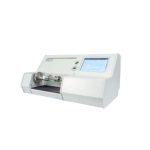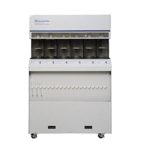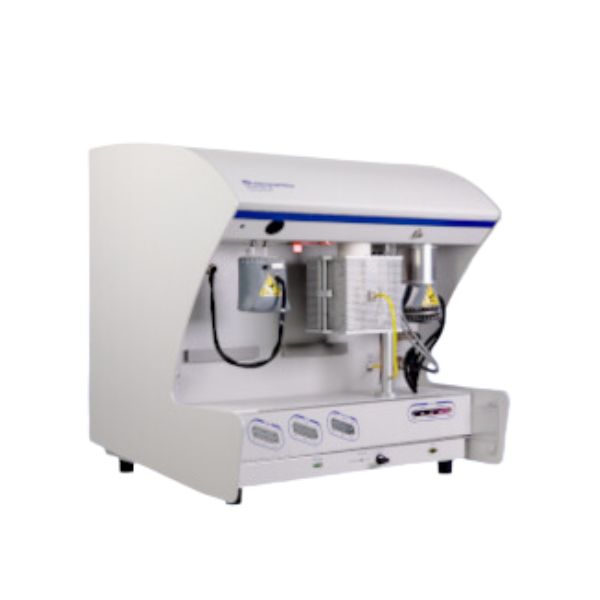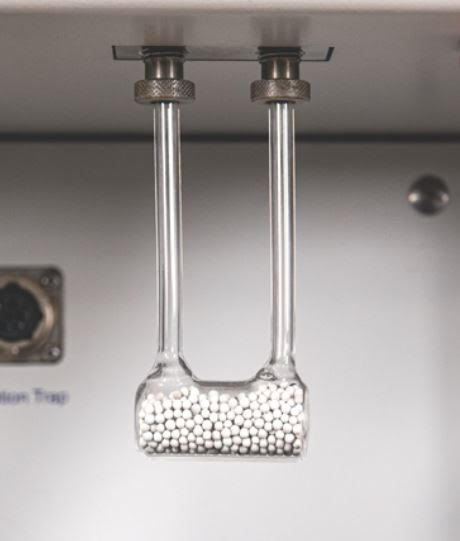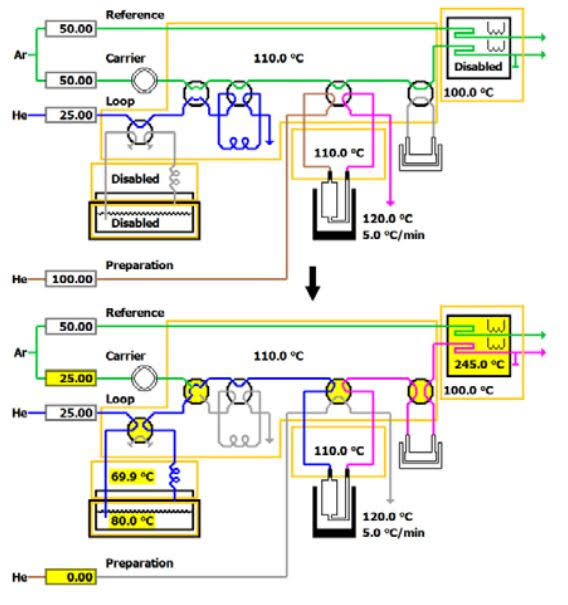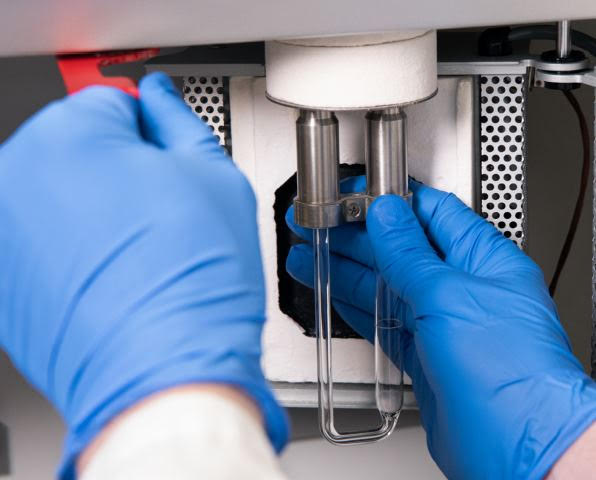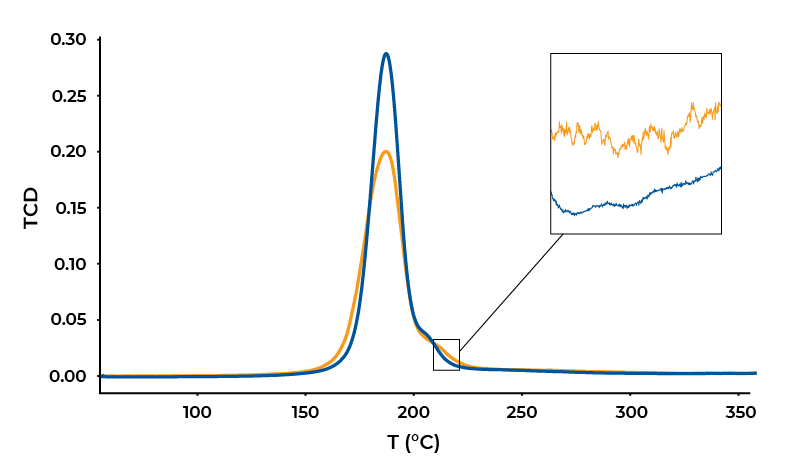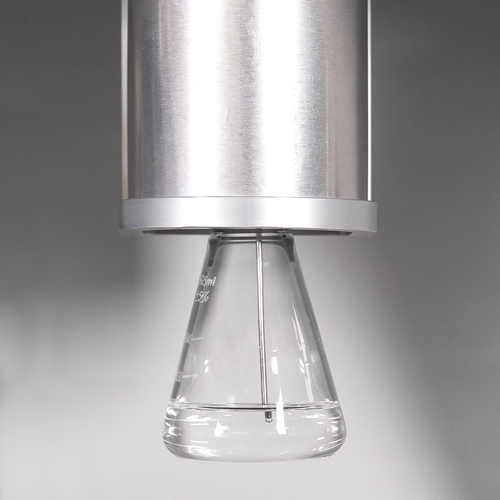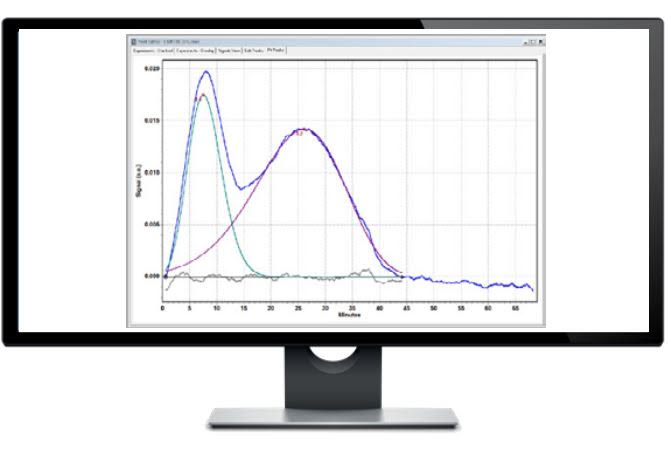General
Automated Catalyst Characterization System
The AutoChem II 2920 is a fully automated chemisorption analyzer that can provide your laboratory with the ability to conduct a comprehensive array of highly precise studies of chemical adsorption and temperature-programmed reactions. With this single instrument, you can acquire valuable information about the physical properties of your catalyst, catalyst support, or other materials. It can determine catalytic properties such as percent of metal dispersion, active metal surface area, acid strength, surface acidity, distribution of strength of active sites, BET surface area, and more. The AutoChem II 2920 performs pulse chemisorption, temperature-programmed reduction (TPR), desorption (TPD), oxidation (TPO), and reaction analyses and does it automatically.
A catalyst characterization laboratory enclosed in one cabinet.
The AutoChem II 2920 is a fully automated chemisorption analyzer that can provide your laboratory with the ability to conduct a comprehensive array of highly precise studies of chemical adsorption and temperature-programmed reactions. With this single instrument, you can acquire valuable information about the physical properties of your catalyst, catalyst support, or other materials. It can determine catalytic properties such as percent of metal dispersion, active metal surface area, acid strength, surface acidity, distribution of strength of active sites, BET surface area, and more. The AutoChem II 2920 performs pulse chemisorption, temperature-programmed reduction (TPR), desorption (TPD), oxidation (TPO), and reaction analyses and does it automatically.
This unit is also available in a Corrosion Resistant version.
Features
Wide Variety of Features and Benefits
Optimum design and efficient utilization of catalysts require a thorough understanding of the surface structure and surface chemistry of the catalytic material. Chemical adsorption (chemisorption) analyses can provide much of the information needed to evaluate catalyst materials in the design and production phases, as well as after a period of use. The chemical adsorption isotherm reveals information about the active surface of a material and has been employed for many years as a standard analytical tool for the evaluation of catalysts. In addition, temperature-programmed reaction techniques have emerged as an indispensable companion to chemisorption isotherm analyses in many areas of industry and research.
- Four internal temperature-controlled zones can be heated independently up to 150 °C. This prevents condensation in the flow path and allows studies to be performed with vapors.
- Low internal plumbing volume assures high resolution, fast detector response, and reduces error when calculating gas volumes.
- Highly sensitive linear thermal conductivity detector (TCD) assures the calibration volume remains constant over the full range of peak amplitudes so the area under the peak is directly proportional to the volume of gas reacted.
- Four high-precision mass flow controllers provide extremely accurate, programmable gas control. This assures a stable baseline and accurate determination of gas volumes.
- Corrosion-resistant detector filaments are compatible with most destructive gases and reduce the likelihood of filament oxidation.
- Clamshell furnace can heat the quartz sample reactor to 1100 °C. Any number of ramp rates and sequences facilitate customized experiments. The KwikCool feature cools the furnace temperature rapidly down to near ambient, reducing analysis time and increasing throughput.
- 18 total gas inlets six each for preparation, carrier, and loop gases permit sequential experiments of different types and saves time between experiments
- Mass spectrometer port and software integration allows virtually simultaneous detection on both the thermal conductivity detector and mass spectrometer.
- Optional Vapor Generator permits analysis using vaporized liquids in an inert carrier stream.
- Optional CryoCooler enables the start of analysis at sub-ambient temperature
Advantages
QUICK & EASY
The new AutoChem III is designed to make key operations quick and easy, saving you hours a day so you can spend less time making measurements and more time making progress
Rapid turnaround with autocool
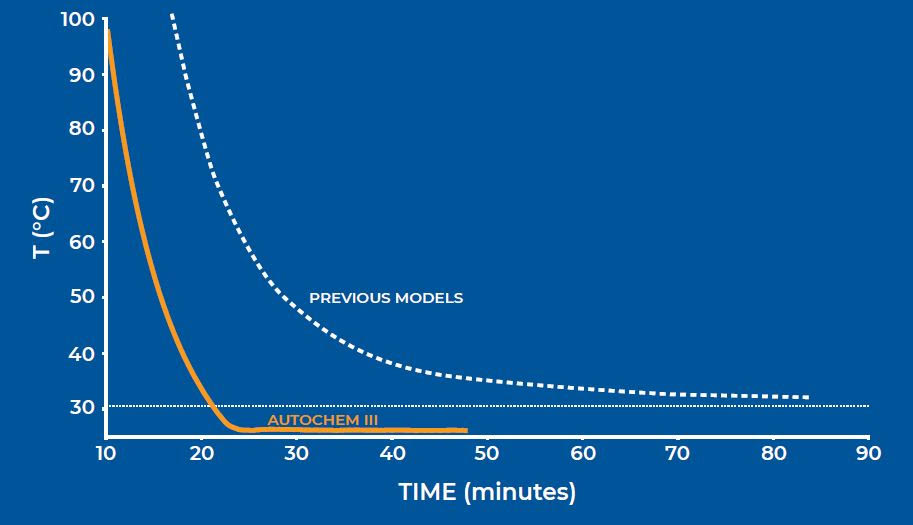
The new AutoChem III is designed to make key operations quick and easy, saving you hours a day so you can spend less time making measurements and more time making progress
Never prepare another vapor capture slush bath
The NEW AutoCool is an integrated gas-fed system that rapidly cools sample tubes before and during experiments. AutoCool is typically 30 minutes faster than alternative systems and requires no liquids or external support. The NEW AutoTrap effectively traps vapor and requires no manual slush bath preparation.
Traditional methods for vapor capture require the time-intensive process of slush-bath preparation through the manual mixing of liquid nitrogen with isopropanol. The zeolite bed of the AutoTrap effectively captures vapors, can be used for several experiments without interruption and can be regenerated in situ.
Program what you envision, visualize what you have programmed
The new MicroActive method editor features an intuitive process illustration that shows the programmed state of the instrument at every step of the method so you can see that your method matches your vision
Making accuracy easy
The AutoChem III makes quantitative accuracy simple with automated detector calibration. Traditional systems require calibration by multiple runs of reference materials or single-point offsets that ignore changes in temperature or pressure.
The AutoChem III generates accurate results through a fully automated process using the system’s patented gas blending capabilities including compensation for injection loop temperature and pressure to ensure the highest calibration – and result – accuracy. The process is fast, automated, requires no operator intervention, and produces more accurate results than alternative designs.
US Pat #10,487,954 B2
Loading samples in a snap
The patented new KwikConnect makes sample tube installation faster, easier, and more reliable than traditional designs with half as many separate pieces and no threaded fittings. Installation and removal are easier and quicker, reduce the risk of breaking sample tubes, and provide peace of mind that the snap lock closure has completely sealed the system
US PAT #11,105,825 B2
Ready to run with 18 available gas streams
Don’t waste time reconnecting and switching gas lines: have what you need ready when you need it. The AutoChem III has 18 available gas streams so you’re always ready to run your next reaction. Having the right blended gas ready also means you won’t introduce errors from poorly designed external gas connections, and you won’t compromise data accuracy by blending gases, which unnecessarily introduces errors from mass flow controllers
BETTER MEASUREMENTS FOR MORE CONFIDENT DECISIONS
The AutoChem III provides results that drive confident decisions. The highest available measurement accuracy and repeatability – made under conditions that match your reaction environment – give you certainty to act with confidence
Precision temperature control
Exacting thermal accuracy is essential to simulate reaction conditions while preventing the deactivation of precious catalyst materials. The AutoChem III exceeds all available systems in every key performance characteristic
- Widest range of temperatures: -100°C to 1200°C
- Widest range of heating rates: 0.1 °C/min to 100 °C/min
- Repeatable temperature profiles
- Accurate determination of activation energy, Ea
- Local sample temperature measurement
- Superior control accuracy without overshoots
- Four independently controlled gas stream temperature zones eliminate vapor condensation and enhance measurement stability
Most accurate gas stream composition
The AutoChem III features the lowest gas flow path volume to eliminate carryover and signal tailing when changing gas flow conditions. This guarantees precise gas stream composition, even when switching configurations from one experiment to another
And with 18 available gas inlets, you will have the gas composition that you need ready, without introducing errors associated with blending gases in situ
BETTER TEMPERATURE CONTROL AT EVERY STEP
- FURNACE: to simulate reaction conditions
- VAPOR: to control vapor composition
- GAS STREAM: to maximize detection sensitivity
- DETECTOR: to ensure robustness
See more of your reaction with the most sensitive chemisorption system in the world
The new AutoChem III features a new thermal conductivity detector (TCD) that is 110% more sensitive than previous designs. This enables you to use lower sample masses, accurately detect secondary reactions, and achieve greater accuracy of catalyst traits like site coverage
Detector sensitivity is enhanced by a reference stream with a dedicated mass flow controller (MFC) that provides a stable reference to the sample stream. Alternative designs use a common carrier stream for both the reference and signal paths, resulting in interference between the measurement and reference stream leading to signal instability
The temperature-controlled TCD is a robust sensor with a long operating life and intrinsic protection from operational errors like gas flow leaks that cause premature failure of 4-element detectors used in inferior designs
Continuous controlled vapor dosing
Achieve faster analysis and more complete characterization of surface selectivity and functionality with the available vapor generator featuring automated vapor calibration, injection repeatability better than 1%, and all new continuous dosing capabilities
This system creates uniform streams of saturated vapors such as water, alcohols, amines, or organics that are used to prepare samples for TPD or as the reaction gas stream
The new continuous dosing capability enables faster and more uniform vapor dosing than legacy systems that are limited to discrete vapor stream pulses
Move quickly from data to decision
Rapidly transition from experimental data to material characteristics with Micromeritics’ own AutoChem data analysis software. Get all the answers you need with:
- Interactive peak analysis including limit selection, baseline definition, integration, and deconvolution
- Built-in analysis models for pulse chemisorption, % dispersion, metal surface area, crystallite size, First-order kinetics, heat of desorption, activation energy, BET, Langmuir, total pore volume, and more
- Seamless integration of mass spec data
- Detailed, configurable graphical reports
IMPROVING OPERATOR SAFETY
- The AutoChem III enhances operator safety at every stage of the measurement, reducing opportunities for exposure and potential for hazardous conditions
No cryogenic liquids
- The new AutoTrap removes moisture without cryogenic liquids such as liquid nitrogen. The AutoTrap also eliminates the need for slush bath preparation, which requires vigorous mixing of alcohols and other solvents in glass vacuum flasks
Cool to the touch third-party tested and verified
- The new AutoCool brings sample tubes to room temperature so fast after every experiment that you can change samples and start the next experiment quickly, without handling hot glass sample tubes. And the KwikConnect sample tube retention system allows you to release the tube in one motion without fumbling with threaded connections and separate adapter pieces
Third-party tested and verified
- Micromeritics products are third-party-tested to conform to the highest level of regulatory compliance and operational safety. Install and run with the confidence that the system will meet or exceed requirements for electrical safety and compatibility with the need for separate qualifications or assessments
Options
MASS SPECTROMETER (MS)
Mass spec provides a direct probe for the identity and quantity of specific reaction products. This is especially valuable when investigating an unknown reaction, or a reaction that creates multiple products
The single quadrupole mass spec with heated transfer line provides detection of mass fragments up to 200 amu and data collection that is integrated with the operation of the AutoChem III
The AutoChem III also includes a general mass spec communication port for coordination with a lab’s existing mass spec
CRYOCOOLER
Begin experiments at temperatures as low as -100 °C with controlled liquid-nitrogen-based cooling
VAPOR GENERATOR
Prepare samples for analysis or perform measurements in the presence of pulsed or continuous vapor streams such as water, alcohol, pyridine, aromatic organics, and more
ENHANCED CORROSION RESISTANCE (ECR)
For reaction chemistries that requires particularly aggressive gas compositions, a special version of the AutoChem III is available with enhanced corrosion resistance. Wetted materials are constructed from highly resistant Hastelloy, highly stable perfluoro elastomers, and inert-coated stainless steel to provide the greatest stability under the harshest working conditions

